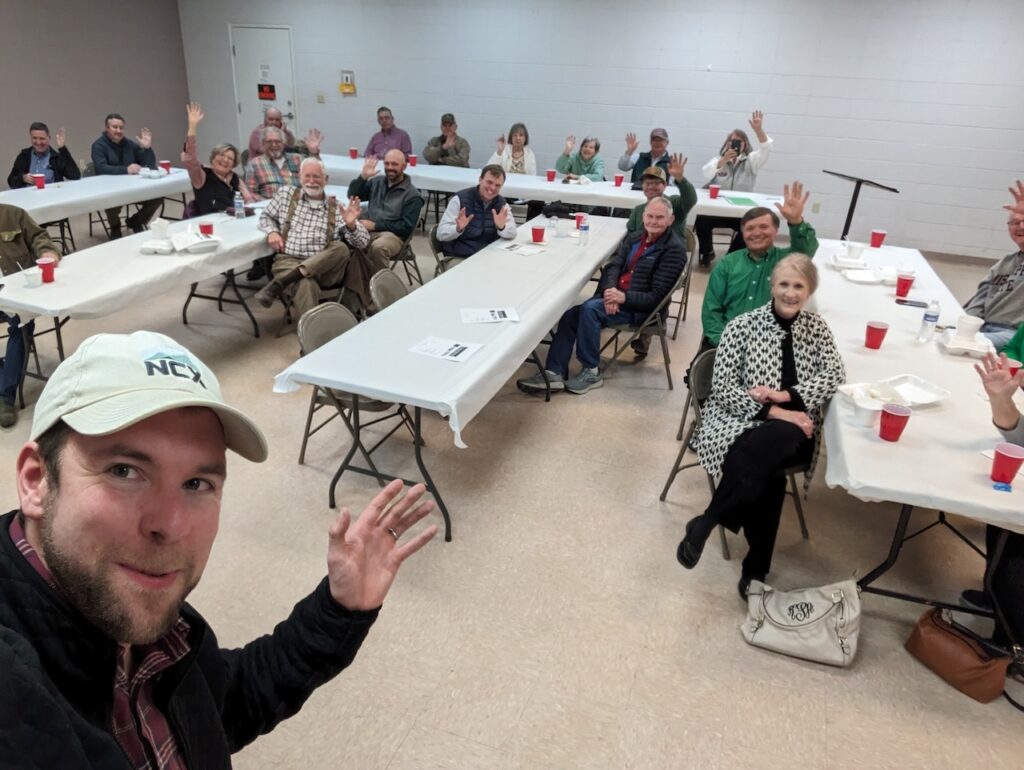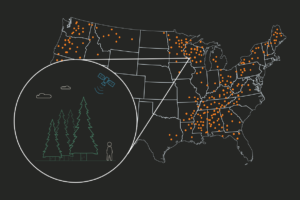This February, NCX founders Zack and Max hit the road to meet with farmers, ranchers, and forest owners all across the US. Our goal was to understand how landowners are evaluating new potential revenue streams for carbon, wildlife, renewable energy, and other values their land provides. What’s working? What’s not? What makes a program pencil out?
Here are some of our top takeaways from our visits with landowners in Alabama, Georgia, Mississippi, Ohio, and Pennsylvania.
1: A new generation is inheriting land
Several of the people we met had recently inherited their property and were trying to find a way to stay on the land. This decade will see tens of thousands of properties pass on to heirs, but keeping a property economically viable can be challenging. Property taxes, maintenance expenses, and rising input costs are leading many first-time landowners to look for new revenue streams for their property.
Common discussion points were:
- Should I stay on my land or should I sell?
- How can I handle tricky family inheritance situations?
- Can I cover property taxes without having to cut down my forest?
- I love my land. How can I help other people engage with nature?

David from Georgia is a dedicated steward of his family’s land. We discussed how recreational programs for hunting, kayaking, camping, and other outdoor experiences can keep a property economically viable without having to harvest those beautiful pines!
2: Managing risks is a top priority
We attended a landowner association meeting in Yalobusha County where the hottest topic of conversation was the Southern Pine Beetle. Due to an unusually hot summer, Mississippi suffered a drought that weakened millions of acres of loblolly pine trees. For landowners across the southern US, a pine beetle infestation can destroy hundreds of thousands of dollars of value almost instantly. It can flip your economics from positive to negative almost overnight.
Pine beetles are just one of many risks we heard about from landowners. One landowner showed us the swath a tornado had cut through his forest. And the Texas panhandle fires were on many landowners’ minds too.
There are several programs (typically administered by the government) that can help landowners reduce their risk exposure, mitigate damages, or recover after a disaster. Some of these programs are first-come-first serve and some are annual grants or cost shares. NCX can help you navigate these options to find the right one for you and your land.

I had a great evening talking about new revenue streams for landowners with the Yalobusha County, Mississippi landowner association. We also learned about several pest and invasives management programs from the MS Forestry Commission.
3: New types of projects are emerging constantly
Project site visits were some of our favorite moments of the trip. We took the opportunity to explore some of the newer types of programs available for landowners. Some of the highlights were:
- An enhanced rock weathering project that was saving landowners money on liming their fields while also storing carbon.
- A reclaimed mine site where bio-enhanced poplar trees were being planted for a carbon project.
- A riverside treehouse for “glamping” – that’s glamorous camping, y’all.
- A ranch using rotational grazing to rebuild soil health while reducing the cost of feed and other inputs.
All of these projects have different risk/reward profiles for landowners to consider. And there are new programs popping up all the time! A lot of our work at NCX is keeping up with all these changes and building tools to evaluate the economics and tradeoffs between different programs. NCX makes it easy for landowners to see if a program pencils out for their land.

Checked out an enhanced rock weathering project in Mississippi. It was my birthday so they let me ride along in the tractor as we spread olivine across a field.

Stopped by a tree planting project on a reclaimed mine site in Ohio. These are often tricky projects because the slopes can be steep and there are only a few inches of soil before you hit some pretty rocky layers of the old mine.
4: Every landowner and every acre is unique
Meeting with so many people in so many different states in such a short period of time really drove home how much variation there is in land management across America. Here is a sampling of the wide range of landowners we met with:
- Ranchers running cattle and timber operations in Alabama
- Row crop growers in Georgia considering a solar development lease
- Regenerative grazers in Ohio
- Both young and old landowners who had recently inherited property
- Professional groups managing thousands of acres for timber and hunting in the floodplains of the Mississippi
- Urban professionals all over who had bought acreage for hunting on the weekends
Every property is unique and every landowner has different goals for their land. There’s no one-size-fits-all approach. NCX’s technology looks at every acre of a property to determine which programs you’re eligible for and how much you could make. We help you find the right program for you and your land.

At the “Heart of America” grazing conference in Ohio, We heard great talks on regenerative grazing practices and low-input agriculture. Didn’t hear any complaints about the strong cattle prices this year!
5: Connecting face-to-face is invaluable
We did a ton of in-person demos on this trip. We loved seeing how easy it was for landowners to create a free NCX account and immediately see which programs their property was eligible for. At that point, they usually stopped paying attention to us and started clicking through the different programs on the NCX marketplace!
But even more than that, we loved hearing the stories about people growing up on the land, seeing it change over the decades, and stewarding it for the next generation. Getting the full context on not only what land people owned but why they owned it helped significantly narrow down which programs might be a good fit.
We didn’t always find a good match, but there are new programs popping up all the time. Now we’re dialed in for their property and can reach back out when we find new programs that might be a good fit.
Although we can’t meet in person with everyone, NCX does offer opportunities for personal connections with our team. Landowners with an NCX account can request a 1-on-1 consultation about their property and get on a call with an NCX expert. We also have a weekly webinar series with an open question and answer session. We look forward to meeting you!

The Ross family wanted to understand the obligations and restrictions of the forest carbon programs their land was eligible for. And yes, we took a LOT of meetings in McDonalds while on the road!
Closing thoughts
Thank you so much to everyone who spent time with us on this tour across the country. You’re why we do what we do at NCX. Helping real landowners get paid to make real change on real acres – that’s what it’s all about.
Miss us on this tour? Join our weekly webinar!
Want NCX to come to your area? Contact us at landowners@ncx.com

On the drive back home to Dallas, I finally saw my first Tesla Cybertruck in the wild! Spotted as I stopped for gas by the Tesla factory in Austin, TX.



